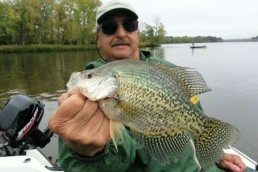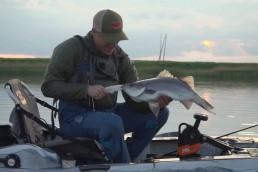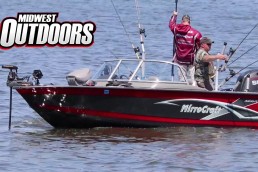The Lakes of Southern Illinois A wealth of fishing, outdoors activities await downstate
SHARE THIS POST
When you think of the Great Lakes, you think of the Midwestern large bodies of water such as Lake Michigan, Lake Erie, etc. Well, there is a different set of “great lakes” in southern Illinois.
Although some of these lakes are situated in the middle of Williamson County, deep in the Shawnee National Forest, you also have Jackson and Johnson counties where some of these waters reside.
Beginning with the largest, you have Rend Lake, at about 18,000 acres, give or take a few depending on the time of the season and rainfall. This lake is known as a premier crappie lake, but there are good catches of white bass, hybrids and giant catfish to make this lake a pleasure to fish.
Crab Orchard Lake is in the Crab Orchard Wildlife Refuge. This lake has all of the fish: largemouths, crappies, catfish and most varieties of panfish. In addition, Crab holds an excellent population of white bass and striped and white bass hybrids. What I like most about this lake is that it is designed more like a “northern-type” lake in that it is a large, shallow-bowl type of lake that I—as a transplanted southerner living in the North—feel more comfortable with. Crab Orchard also has all the camping and boating an outdoors person could want.
Next on my list of is Kinkaid Lake , a body of water 2,750 acres in size which holds bass and crappies, but also has the added bonus of being a first-class lake for muskies. Catches of 40-plus-inch muskies are common and some over 50 are available. Again, this lake has all the amenities to make a visit comfortable and interesting with camping, marinas, etc.
Are you enjoying this post?
You can be among the first to get the latest info on where to go, what to use and how to use it!
Lake of Egypt is sort of a “transition lake,” meaning one end of the lake is large and surrounded by many homes, while the other end is more like a normal impoundment lake with many fingers and arms to wander through, sort of two lakes in one. Egypt is geared toward the fisherman in that it has a speed limit of 35 mph and has no wake and no water skiing areas marked off so fishermen and water enthusiasts can co-exist in harmony. This is a 2,400-acre power plant lake that usually doesn’t freeze up. If you want to brave the colder winter temps, you can fish this lake year ‘round. It produces excellent catches of slab-sized crappies and bragging-sized bass. In addition, Egypt holds a state record for a 20-pound, 1/32-ounce hybrid striped bass, although the hybrids are very rare these days.
The next southern Illinois water is Cedar Lake, which is 1,750 acres of sheer beauty and wilderness. This underfished lake in the heart of the Shawnee National Forest has all the trappings of some remote northern lakes, with the lack of any official campgrounds, marinas, etc. If you want to get away from it all, this is the lake for you. Cedar is noted for its plentiful and consistent bass fishing. Limits of 2-pound bass are common and crappies can be large. Cedar Lake also has a small population of smallmouths, walleyes and northern pike to give you an occasional surprise at the end of your line. If there is any drawback to this lake it’s that it is only a 10-hp-limit lake.
If you want to continue on with the serenity in Shawnee, you have the sister lakes of Little Grassy, at 1,000 acres, and Devils Kitchen, at 810 acres. Both have beauty and good fishing. These two are also 10-hp-limited lakes. Little Grassy’s notoriety comes from its limit catches of slab crappies and excellent bass fishing coupled with its surroundings. This lake does have camping facilities for those who like to “rough” it. On the other hand, on Devils Kitchen, rumor has it that it’s a little “tougher” lake to fish because of its deeper (86 feet), colder and clearer water. The rewards are paid off in 10-inch-plus bluegills and 4-pound bass. And if you are in the know, word is that some nice rainbow trout can be caught near the dam at night. And although there are none present now, I personally think this would be an excellent lake to establish a good population of smallmouth bass—the lake has the depth, cooler, deeper waters and is somewhat non-fertile with much sand and gravel, just right for smallmouth habitat. If southern Illinois lacks in any department at all, it is in the smallmouth habitat.
Last, and absolutely not the least, is a little overlooked 144-acre lake called Murphysboro. Those venturing over to the much larger Kinkaid Lake often pass on this lake. Many are missing much of the pleasures that small lakes can provide. First and foremost, you have a captive “audience,” as the fish just don’t have that far to run. Second, small lakes like Murphysboro are excellent “kid” waters in that they host large quantities of panfish, including some decent-sized crappies. And third, the bass are usually large enough to practice on until that trip to the “bigger” lake. I say this somewhat tongue-in-cheek, because if you have read any of my past articles you would know that many state-record fish are often recorded out of very small lakes and ponds so don’t ever sell a small lake short, as Murphysboro can be one of those sleeper lakes.
You can spend your whole season fishing here in southern Illinois for all the species you care to enjoy and never travel more than 25 miles from one destination to another, saving costs. If you would like more information on these “great lakes,” get yourself a 2016 State of Illinois Fishing Information booklet and choose the lake that will suit you the best. MWO
MWO
SHARE THIS POST
Did you enjoy this post?
You can be among the first to get the latest info on where to go, what to use and how to use it!




